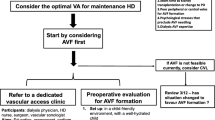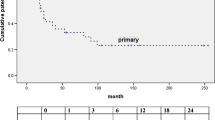Abstract
Background
Despite the Fistula First initiative there is still reluctance to use arteriovenous fistulas (AVF) for chronic haemodialysis (HD) in children. Our aim was to compare outcomes of AVFs and central venous lines (CVL) in children on chronic HD in a centre where AVF is the primary choice for vascular access.
Patients and methods
This was a retrospective case notes analysis of access complications, dialysis adequacy and laboratory outcomes in children who underwent dialysis for at least a year by AVF (n = 20, median age 14.2 years, range (2.9–16.5) and CVL (n = 5, median age 2.4 years, range 2.0–12.2) between January 2007 and December 2010.
Results
Primary access failure rate (patient-months) was 1 per 78.8 for AVF (n = 5) and 1 per 15.5 for CVLs (n = 7, p = 0.3). Failure thereafter was 1 per 131.3 and 1 per 18.5 for AVF and CVLs respectively (n = 3 and 6 respectively; p = 0.2). The annualised hospitalisation rate for access malfunction was 0.44% and 3.1% for AVFs and CVLs respectively (p = 0.004). Patients with AVFs had a lower infection rate of 0.25 per 100 patient-months compared with CVL at 3.2 per 100 (p = 0.002). There was no difference in dialysis adequacy or laboratory values between AVF and CVL groups. Access survival rates (including both primary and secondary access failure) were significantly higher for AVF compared with CVL (p = 0.0002, hazard ratio = 0.15, 95% confidence interval 0.04–0.37).
Conclusions
Patients with AVF spend less time in hospital than those dialysed by CVLs and have a much lower access infection rate. These findings emphasise the need to use AVF as first-line access for paediatric patients on chronic HD.

Similar content being viewed by others
References
Centers for Medicare & Medicaid Services (1999) Centers for Medicare & Medicaid Services: ESRD special project—developing clinical performance measures for care of patients with end stage renal disease, final report. Clinical performance measure: vascular access I: maximising placement of arterial venous fistulae (AVF). p 19
De Souza RA, Oliveira EA, Penido Silva JM, Lima EM (2011) Haemodialysis vascular access in children and adolescents: a 10-year restrospective cohort study. J Bras Nephrol 33:422–430
Zaritsky JJ, Salusky IB, Gales B, Ramos G, Atkinson J, Allestead A, Brandt ML, Goldstein SL (2008) Vascular access complications in long-term pediatric hemodialysis patients. Pediatr Nephrol 23:2061–2065
Chand DH, Bendnarz D, Eagleton M, Krajewski L (2009) A vascular access team can increase AV fistula creation in pediatric ESRD patients: a single center experience. Semin Dial 22:679–683
Fishbach M, Edefonti A, Schroder C, Watson A, The European Pediatric Dialysis working group (2005) Hemodialysis in children: general practice guidelines. Pediatr Nephrol 18:1172–1176
Chand DH, Valentini RP (2008) International pediatric fistula first initiative: a call to action. Am J Kidney Dis 51:1016–1024
Hayes WN, Watson AR, Callagan N, Wright E, Stenfanidis CJ, The European Pediatric Dialysis Working Group (2011) Vascular access: choice and complications in European paediatric haemodialysis units. Pediatr Nephrol 27:999–1004
Fadrowski JJ, Hwang W, Neu AM, Fivush BA, Furth SL (2009) Patterns of use of vascular catheters for hemodialysis in children in the United States. Am J Kidney Dis 53:91–98
Chand DH, Valentini RP, Kamil ES (2009) Hemodialysis vascular access options in pediatrics: considerations for patients and practitioners. Pediatr Nephrol 24:1121–1128
National Kidney foundation (2006) (K-DOQI) Clinical practice guidelines and clinical practice recommendations for 2006 updates: haemodialysis adequacy, peritoneal dialysis and vascular access. Am J Kidney Dis 48 [Suppl]:S1–S322
Annual Report of North America Paediatrics Renal Trials and Collaborative Studies(NAPRTCS) (2008) http://spitfire.emmes.com/study/ped/annlrept/Annual
Vazquez MA (2009) Vascular access for dialysis: recent lessons and new insights. Curr Opin Nephrol Hypertens 18:116–121
Wander JV, Moore ES, Jonasson O (1970) Internal arteriovenous fistulae for dialysis in children. J Pediatr Surg 5:533–538
North American Pediatric Renal Trials and Collaborative Studies (NAPRTCS) (2006) Annual Report. Dialysis Access Data 2006
Sheth RD, Brandt M, Brewer ED, Nuchtern JG, Kale AS, Goldstein LS (2002) Permanent hemodialysis vascular access survival in children and adolescents with end-stage renal disease. Kidney Int 62:1864–1869
Goolsb MJ (2002) National Kidney Foundation Guidelines for chronic kidney disease: evaluation, classification, and stratification. J Am Acad Nurse Pract 14:238–242
Briones L, Diaz Moreno A, Sierre S, Lopez L, Lipsich J, Adragna M (2010) Permanent vascular access survival in children on long-term chronic hemodialysis. Pediatr Nephrol 25:1731–1738
Miguel JJ, Chow J (2009) Vascular dialysis access flow measurement: early intervention through early detection. J Ren Care 35:185–191
Author information
Authors and Affiliations
Corresponding author
Rights and permissions
About this article
Cite this article
Ma, A., Shroff, R., Hothi, D. et al. A comparison of arteriovenous fistulas and central venous lines for long-term chronic haemodialysis. Pediatr Nephrol 28, 321–326 (2013). https://doi.org/10.1007/s00467-012-2318-2
Received:
Revised:
Accepted:
Published:
Issue Date:
DOI: https://doi.org/10.1007/s00467-012-2318-2




